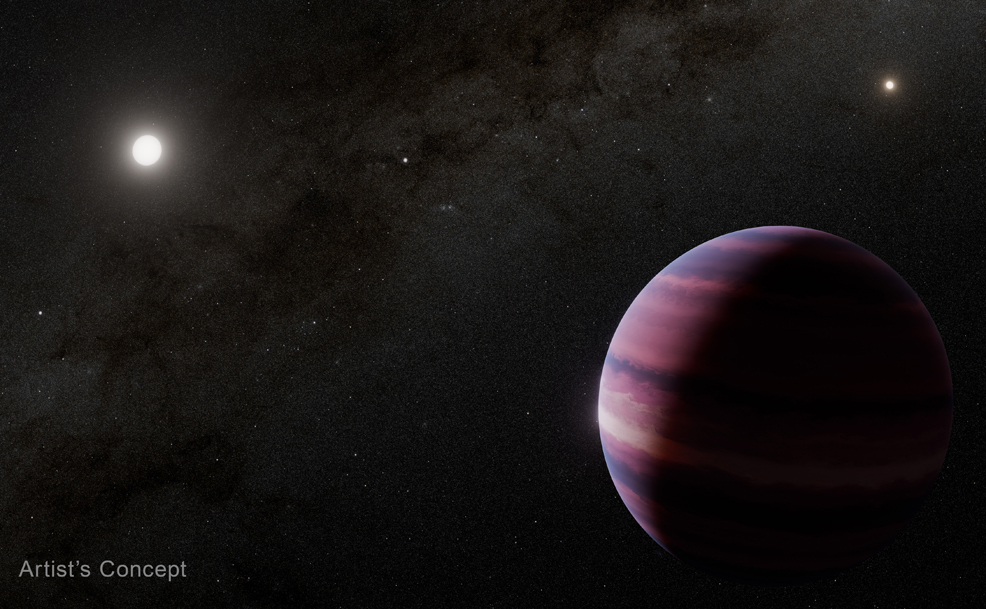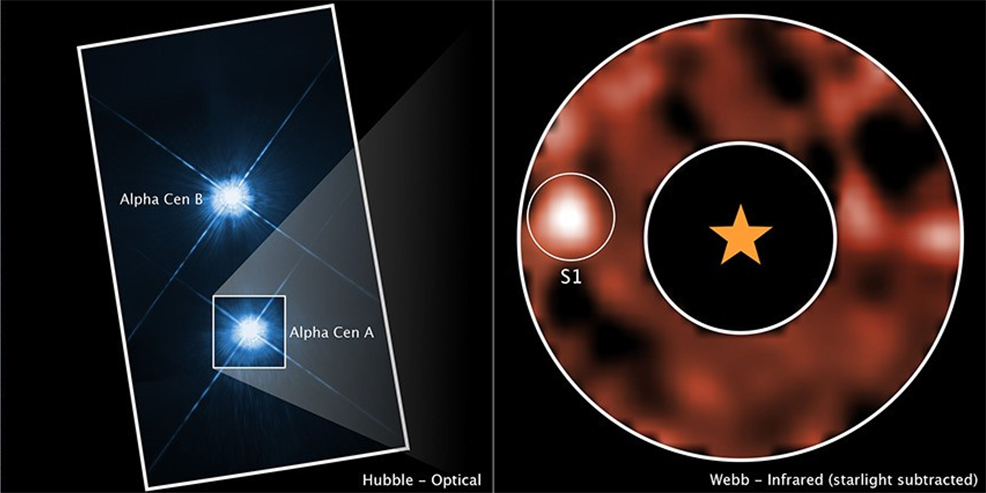
20th August 2025 Strong evidence of a gas giant in Alpha Centauri system NASA reports the strongest evidence to date of the hypothetical Alpha Centauri Ab, a gas giant orbiting Alpha Centauri A – one of three stars that form the nearest star system to our own.
Astronomers using the James Webb Space Telescope (JWST) have discovered compelling signs of a new planet – Alpha Centauri Ab – in our closest neighbouring star system. Using the Mid-Infrared Instrument (MIRI) with a coronagraph to block out the star's glare, they detected a faint point of light at between 1 and 2 AU (one to two times the distance between Earth and the Sun) from its star. Based on the brightness of the object in these mid-infrared observations, along with orbital simulations, the researchers calculated its likely characteristics. According to the team, Alpha Centauri Ab is estimated at 90 to 150 Earth masses – similar to Saturn – and spans about 1 to 1.1 times the diameter of Jupiter. Although its temperature is only around 225 K (–48 °C), it lies within the habitable zone. It travels on a somewhat egg-shaped, eccentric path, and has a rather tilted stance, leaning at least 50° relative to the system's orbital plane. Alpha Centauri, visible only from the southern hemisphere on Earth, is a triple star system that consists of the binary Alpha Centauri A and Alpha Centauri B – both Sun-like stars – and the faint red dwarf star Proxima Centauri. Alpha Centauri A is the third brightest star in the night sky. While there are two confirmed planets and a third potential candidate orbiting Proxima Centauri, the presence of other worlds surrounding the larger Alpha Centauri A and B has proved challenging to confirm. In 2012, astronomers thought they had found a rocky world around Alpha Centauri B, but that signal turned out to be noise. Later efforts with ground-based telescopes offered intriguing but inconclusive hints of a larger planet around Alpha Centauri A. In 2021, analysis of Very Large Telescope data suggested a possible Neptune-sized candidate, though confirmation proved elusive. These tantalising signs kept the search alive and paved the way for Webb to take a closer look. Beginning in August 2024, several rounds of meticulously planned observations by Webb, careful analysis by the research team, and detailed computer modelling helped to determine that the source seen in the image below (marked with "S1") is likely a planet, and not a background object (like a galaxy), foreground object (such as a passing asteroid), or other detector or image artefact.
"If confirmed, the potential planet seen in the Webb image of Alpha Centauri A would mark a new milestone for exoplanet imaging efforts," said PhD student Aniket Sanghi of Caltech in Pasadena, California. "Of all the directly imaged planets, this would be the closest to its star seen so far. It's also the most similar in temperature and age to the giant planets in our Solar System, and nearest to our home, Earth. Its very existence in a system of two closely separated stars would challenge our understanding of how planets form, survive, and evolve in chaotic environments." "With this system being so close to us, any exoplanets found would offer our best opportunity to collect data on planetary systems other than our own. Yet these are incredibly challenging observations to make, even with the world's most powerful space telescope, because these stars are so bright, close, and move across the sky quickly," explained Charles Beichman, executive director of the NASA Exoplanet Science Institute, and co-first author on two new papers. "Webb was designed and optimised to find the most distant galaxies in the universe. The operations team at the Space Telescope Science Institute had to come up with a custom observing sequence just for this target, and their extra effort paid off spectacularly." The Nancy Grace Roman Space Telescope, set to launch in 2027, will test new technologies to observe binary and trinary systems like Alpha Centauri. Its visible light data should complement Webb's infrared observations, yielding more insights on this object, including the precise size, reflectivity, and other characteristics. Although unlikely to support life as we know it, ostensibly being a gas giant, its placement within the habitable zone raises the intriguing possibility of moons orbiting it – worlds that might have conditions suitable for liquid water. These "exomoons", if they exist, could become natural targets for future telescopes, extending the search for habitability. If the planned follow-up studies confirm the existence of a planet, it would be a milestone in exoplanet science, demonstrating how far our instruments have advanced in probing even the brightest and most challenging nearby stars. The insights gained will guide next-generation observatories and missions, building a bridge between today's faint detections and tomorrow's detailed surveys. Decades from now, improvements in direct imaging may allow astronomers to view this and other planets with high resolution, revealing their atmospheres and weather systems in breathtaking detail. Centuries from now, if humans or their AI and robotic descendants make the 4.3 light-year journey to Alpha Centauri, this could be one of the first exoplanets they study up close – turning a formerly pixelated blur into a world as real and familiar as the planets of our own Solar System.
Credit: NASA
Comments »
If you enjoyed this article, please consider sharing it:
|
||||||








